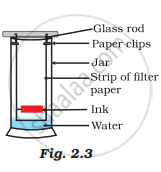Advertisements
Advertisements
Question
Solve the following problem:
Write the following number in ordinary decimal form:
0.011 × 10−3
Solution
0.011 × 10−3 = 0.000011
APPEARS IN
RELATED QUESTIONS
Calculate the amount of carbon dioxide that could be produced when 2 moles of carbon are burnt in 16 g of dioxygen.
What is the concentration of sugar (C12H22O11) in mol L–1 if its 20 g are dissolved in enough water to make a final volume up to 2 L?
A sample of drinking water was found to be severely contaminated with chloroform, CHCl3, supposed to be carcinogenic in nature. The level of contamination was 15 ppm (by mass).
- Express this in percent by mass.
- Determine the molality of chloroform in the water sample.
Explain the term mole fraction
Solve the following problem:
Find out the molar mass of the following compounds:
Copper sulphate crystal (CuSO4.5H2O)
(At. mass: Cu = 63.5; S = 32; O = 16; H = 1; Na = 23; C = 12; Fe = 56; N = 14)
Solve the following problem:
Write the following number in ordinary decimal form:
3.49 × 10−11
Solve the following problem:
Write the following number in ordinary decimal form:
3.75 × 10−1
Solve the following problem:
Write the following number in ordinary decimal form:
5.16 × 104
Solve the following problem:
Write the following number in ordinary decimal form:
43.71 × 10−4
Solve the following problem:
Perform the following calculation. Round off your answer to two digits.
`1/(3.40xx10^24)`
Solve the following problem:
Perform the following calculation. Round off your answer to two digits.
`((4xx10^-3)(9.9xx10^-7))/((789)(1.002xx10^-10)(0.3xx10^2))`
Solve the following problem:
Perform the following calculation. Round off your answer to three digits.
`(8.94xx10^6)/(4.35xx10^4)`
Solve the following problem:
Perform the following calculation. Round off your answer to three digits.
`((9.28xx10^9)(9.9xx10^-7))/((511)(2.98xx10^-6))`
Solve the following problem:
A 1.000 mL sample of acetone, a common solvent used as a paint remover, was placed in a small bottle whose mass was known to be 38.0015 g.
The following values were obtained when the acetone - filled bottle was weighed: 38.7798 g, 38.7795 g and 38.7801 g. How would you characterise the precision and accuracy of these measurements if the actual mass of the acetone was 0.7791 g?
Solve the following problem:
Your laboratory partner was given the task of measuring the length of a box (approx 5 in) as accurately as possible, using a metre stick graduated in milimeters. He supplied you with the following measurements:
12.65 cm, 12.6 cm, 12.65 cm, 12.655 cm, 126.55 mm, 12 cm.
Give your reason for rejecting each of the others.
When light is passed through water containing a few drops of milk, it shows a bluish tinge. This is due to the ______ of light by milk and the phenomenon is called ______. This indicates that milk is a ______ solution.
Non-metals are usually poor conductors of heat and electricity. They are non-lustrous, non-sonorous, non-malleable and are coloured.
Name a lustrous non-metal.
A child wanted to separate the mixture of dyes constituting a sample of ink. He marked a line by the ink on the filter paper and placed the filter paper in a glass containing water as shown in Fig.2.3. The filter paper was removed when the water moved near the top of the filter paper.
(i) What would you expect to see, if the ink contains three different coloured components?
(ii) Name the technique used by the child.
(iii) Suggest one more application of this technique.

Calculate the mass of sodium sulphate required to prepare its 20% (mass percent) solution in 100g of water?
What will be the molality of the solution containing 18.25 g of \[\ce{HCl}\] gas in 500 g of water?
Sulphuric acid reacts with sodium hydroxide as follows:
\[\ce{H2SO4 + 2NaOH -> Na2SO4 + 2H2O}\]
When 1 L of 0.1 M sulphuric acid solution is allowed to react with 1 L of 0.1 M sodium hydroxide solution, the amount of sodium sulphate formed and its molarity in the solution obtained is:
(i) 0.1 mol L–1
(ii) 7.10 g
(iii) 0.025 mol L–1
(iv) 3.55 g
Which of the following solutions have the same concentration?
(i) \[\ce{20 g of NaOH in 200 mL of solution}\]
(ii) \[\ce{0.5 mol of KCl in 200 mL of solution}\]
(iii) \[\ce{40 g of NaOH in 100 mL of solution}\]
(iv) \[\ce{20 g of KOH in 200 mL of solution}\]
Which of the following terms are unitless?
(i) Molality
(ii) Molarity
(iii) Mole fraction
(iv) Mass percent
What is the difference between molality and molarity?
If 4 g of \[\ce{NaOH}\] dissolves in 36 g of \[\ce{H2O}\], calculate the mole fraction of each component in the solution. Also, determine the molarity of solution (specific gravity of solution is 1g mL–1).
What quantity (in mL) of a 45% acid solution of a monoprotic strong acid must be mixed with a 20% solution of the same acid to produce 800 mL of a 29.875% acid solution?
The molarity of urea (molar mass 60 g mol−1) solution by dissolving 15 g of urea in 500 cm3 of water is ______.
